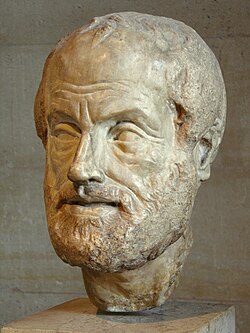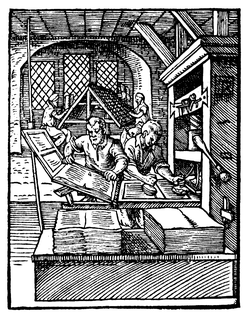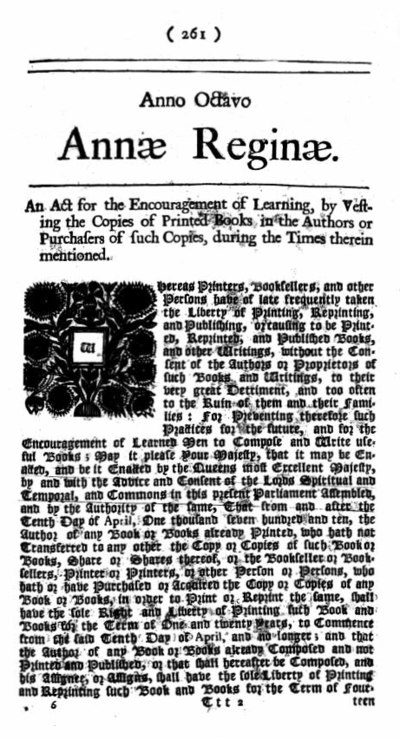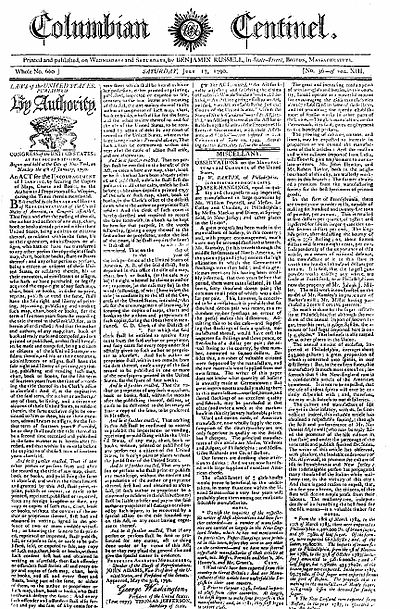History of copyright
Note: This is a draft straw dog proposal for inclusion in the materials.
| “ | They hang the man and flog the woman Who steals the goose from off the common But leave the greater villain loose Who steals the common from off the goose. Anonymous protest poem 1764 or 1821. |
” |
Contents
Orientation
Copyright: A foreign concept to the ancient mind

| “ | Imitation is natural to man from childhood [and] the first things that he learns come to him through imitation (Aristotle, 2004[1]) | ” |
The ancients had no proscriptions against copying or what we conceive today as plagiarism. Our ancestors' understanding of the world was housed in stories – not dogma. Storytellers had no “moral” right to protect their tales. No one questioned the right of anyone to copy these and other works. “The concept of copyright was utterly foreign to the ancient mind” (Harpur, 2004, p. 141[2]).
Going to war for the right to copy of a book
In Ireland in the sixth century there occurred the earliest known judgment on the right to copy. An Irish monk, Columcille, copied without permission St. Jerome's psalter, a hymn book belonging to St. Finnian, the abbot of another monastery. Finnian asked Columcille to return the copy of the book claiming it to be stolen property and was refused. Finnian appealed to the High King of Ireland, King Diarmait, who pronounced the judgement in Finnians favour: “To every cow its calf to every book its copy.” Columcille responded to this adverse judgement with force and met the king's men in battle at Cuildremne in 561. Columcille was triumphant and King Diarmait was exiled from Ireland, but as a result more than 3 000 men lay dead (Thomas, 2004[3]). Columcille was later also exiled to Scotland, where he is known as St. Columba (Concannon, 2004[4]). It could be said that although he lost the court case, with the battle, he won his point. This battle resolved the copyright issue in favour of openness for more than a millennium. The Irish monks continued copying books, spread out from Scotland, and brought the enlightenment to Europe (Cahill, 1995[5]).
Many authors but only a few presses: An early distribution monopoly

It is during this period that copying without referencing the author became socially unacceptable. Ben Johnson was one of the first authors to use the term “plagiary” in English with its current meaning. The Oxford English Dictionary provides an earlier reference from Montagu in 1621, who used the word “plagiarisme” in the sense of purloining someone's work (Oxford University Press, n.d.[7]). Howard (1988[8]) argues, therefore, that plagiarism is a historical construction rather than a moral category. Downes (2003[9]), acknowledges that plagiarism, while being mendacious, is not theft. Rather it is “a breach of trust between the plagiarizer and the reader . . . a misrepresentation of one's self as something one is not.”
Origins of copyright
Our modern concept of copyright in British common law has developed from the Statute of Queen Anne 1710 An Act for the Encouragement of Learning. It was passed for the purpose of promoting learning, specifically to encourage “learned men to compose and write useful books” (House of Commons, 1709[10]). Up until then, the publishers could pass on their royal grants of copyright to their heirs in perpetuity. This Act was a consequence of the 1707 Act of Union with Scotland to form the United Kingdom of Great Britain. Scottish booksellers would not accept the English monopoly of the London Stationers' Company. This first copyright law had the purpose of breaking the Stationers' monopoly and so, it was not a mechanism for protecting copyright controller's rights as it is often portrayed nowadays. A number of features of the Act served the interests of the general public, for instance (see Rimmer 2007[11]):- The limitation of the duration of the controllers' rights (previously indefinite) thus ensuring that works would enter the public domain.
- The requirement for copies of books to be placed in university libraries thus ensuring public access to copyrighted works.
Therefore, copyright law was expressly introduced to limit the rights of the previous monopoly of control.
In the Statute of Queen Anne, copyright was wrested from the printers and vested in the authors. This right was limited to a maximum of 28 years, after which works entered the public domain. So in effect, this statute created the public domain – the intellectual commons. This is the most important aspect of this law for the public and for education. It created a body of works that could be copied, altered, adapted, or tweaked by anyone for amusement, profit, or enlightenment. In addition, Article IX gave a special exemption to universities to ensure that none of their traditional copying rights were affected. This was no coincidence, intellectuals like John Locke actively campaigned for the repeal of the monopoly in the book trade and strongly condemned the restrictions on science caused by the monopolies of the Stationers Company (Locke, 1692[12]).
Forté (2000[13]) explains: “Copyright isn't on a par with the right to life, liberty, fraternity and equality before the law. It's a privilege extended to us by our fellow citizens because they recognise the value they get out of our efforts.” Copyright was never intended to be primarily a vehicle for protecting the rights of the copyright holders. On the contrary, copyright was initiated specifically to promote learning by removing the perpetual rights of the copyright controllers transferring the rights to the authors and imposing a reasonable time limit on their privilege.Most of the colonies that formed the United States had laws that were based on the Statute of Queen Anne (Shirata, 1992[14]). So it is not co-incidental that the U.S. Constitution echoes this purpose. It specifically refers to Congress's duty in Article I Section 8:
| “ | To promote the progress of science and useful arts, by securing for limited times to authors and inventors the exclusive right to their respective writings and discoveries (U.S. Constitutional Convention, 1787[15]). | ” |
This was followed by the Copyright Act 1790: An Act for the Encouragement of Learning and it was signed by George Washington (Washington, 1790[16]). Like the Statute of Queen Anne, this act (as the title suggests) was enacted specifically for the “encouragement of learning” and is meant to protect the rights of copyright holders only insofar as it serves that purpose. Thomas Jefferson (1813[17]) expressly opposed linking copy rights to property rights, writing “Inventions then cannot, in nature, be a subject of property.” President Madison wrote that “incentive, not property, or natural law is the foundational justification for American copyright” (as cited in Vaidhyanathan, 2001, p. 43[18]). So, there is no common law support for IP. It is a privileged monopoly, not a right. Since these laws were first enacted, the copyright controllers have successfully waged a continuous war aiming to extend their rights at the expense of education and the general public, morphing the meaning of copyright in the public’s mind to become “intellectual property.”
Note that other countries have different traditions, for example most of continental Europe, Francophone Africa and Latin America follows the Napoleonic Code, which is based on “droit d’auteur” (author’s rights). Indigenous copyright too follows varied customs and traditions.
Closing reflection
Copyright law was expressly introduced to limit the rights of the controllers and distributors of knowledge. Yet, these controllers are successfully turning a “copy” right into a property right. The traditional rights of learning institutions are being taken away. The balance for researchers should be restored. Research and learning must be allowed the broad interpretation that was intended in the original laws.
Fortunately, in a digital world, Creative Commons provides the legal tools for education institutions to restore the balance by granting permissions and freedom to create new knowledge without restriction.
Further reading
We recommend the following sources for further reading:
|
Acknowledgements
This subsection was adapted from:
McGreal, R. (2004). Stealing the goose: Copyright and learning. International Review of Research in Open and Distance Learning, 5(3). Retrieved from http://www.irrodl.org/index.php/irrodl/article/view/205
References
- ↑ 1.0 1.1 Aristotle. (2004, April). The Poetics. Retrieved September 9, 2004 from: http://www.authorama.com/the-poetics-5.html
- ↑ Harpur, T. (2004). The Pagan Christ: Recovering the Lost Light.Toronto: Thomas Allen.
- ↑ Thomas, J. B. (2004). St. Columba [Electronic version]. The Catholic Encyclopedia, Volume IV. Retrieved March 25, 2004 from: http://www.newadvent.org/cathen/04136a.htm
- ↑ Concannon, K. (2004, July 1). St. Columcille: Ireland's first 'White Martyr' [Electronic version]. Catholic Herald. Retrieved August 20, 2004 from: http://www.catholicherald.com/articles/04articles/columcille.htm
- ↑ Cahill, T. (1995). How the Irish saved civilization: The untold story of Ireland's heroic role from the fall of Rome to the rise of medieval Europe (Vol. I). New York: Doubleday.
- ↑ Editors. (2004, August). Stationers Company. Literary Encyclopedia. Retrieved September 7, 2004 from: http://www.litencyc.com/php/stopics.php?rec=true&UID=1309
- ↑ Oxford University Press. (n.d.). Oxford English Dictionary: plagiarize. Retrieved September 9, 2004 from: http://0-dictionary.oed.com.aupac.lib.athabascau.ca/cgi/entry/00180580
- ↑ Howard, R. M. (1988). Review of Mallon, Thomas. Stolen Words: Forays into the origins and ravages of plagiarism. New York: Ticknor and Fields, 1989. Retrieved September 9, 2004 from: http://english.ttu.edu/kairos/3.1/reviews/howard/mallon.html
- ↑ Downes, S. (2003, April). Copyright, ethics and theft [Electronic version]. </nowiki>Journal of the United States Distance Learning Association, 17(2). Retrieved May 13, 2003 from: http://www.usdla.org/html/journal/ED_APR03.pdf
- ↑ House of Commons. (1709). An Act for the Encouragement of Learning, by Vesting the Copies of Printed Books in the Author's or Purchasers of Such Copies. Retrieved October 28, 2003 from: http://press-pubs.uchicago.edu/founders/documents/a1_8_8s2.html
- ↑ Rimmer, M. (2007) Digital copyright and the consumer revolution: hands off my iPod Edward Elgar Publishing. Available online: http://www.google.com/books?id=1ONyncVruj8C&dq=statute+of+anne+copyright+scotland&as_brr=3&source=gbs_navlinks_s%7C isbn = 9781845429485
- ↑ Locke, J. (1692, January 2). A letter to Clarke. Retrieved September 6, 2004 from: http://orion.mt.tama.hosei.ac.jp/hideaki/twocopy.htm
- ↑ Forté, B. (2000, June 15). The Statute of Queen Anne. Retrieved September 1, 2004 from: http://betweenborders.com/queenanne/
- ↑ Shirata, H. (1992). The origin of two American copyright theories: A case of the reception of English law. Retrieved September 6, 2004 from: http://orion.mt.tama.hosei.ac.jp/hideaki/twocopy.htm
- ↑ U.S. Constitutional Convention. (1787). Constitution of the United States. Retrieved September 1, 2004 from: http://www.law.cornell.edu/constitution/constitution.articlei.html#section8
- ↑ Washington, G. (1790, July 17). The First U.S. Copyright Law [Electronic version]. Columbian Centinel. Retrieved August 21, 2004 from: http://earlyamerica.com/earlyamerica/firsts/copyright/
- ↑ Jefferson, T. (1813, August 13). Thomas Jefferson letter to Isaac McPherson 13:333--34 [Electronic version]. Foundation Constitution, 16(25). Retrieved August 21, 2004 from: http://press-pubs.uchicago.edu/founders/documents/v1ch16s25.html
- ↑ Vaidhyanathan, S. (2001). Copyrights and copywrongs: the rise of intellectual property and how it threatens creativity. New York: New York University Press.


